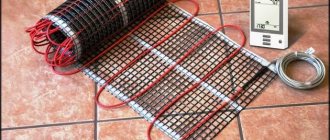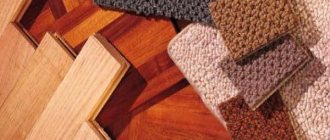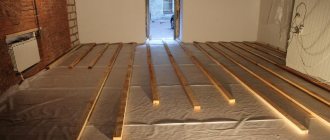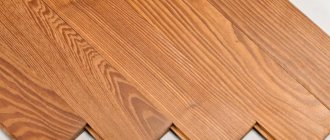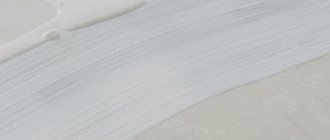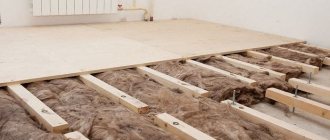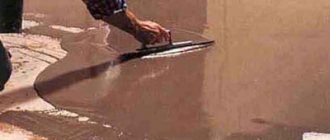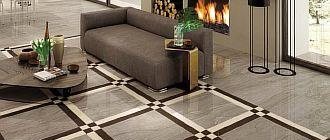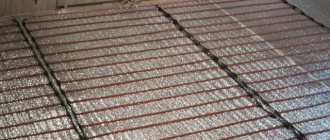High-quality finishing work largely depends on the correctly selected material. Thanks to modern technologies, the construction market is saturated with various options. But for rough or finishing floor coverings, the most popular are OSB, plywood, chipboard, fiberboard and MDF. This variety allows you to select a product to perform specific tasks.
Varieties
Solid board
It belongs to the premium type of flooring; it symbolizes a natural wooden floor. It is usually made from valuable wood species - oak, walnut, maple, acacia, as well as exotic and especially durable species. It is coated with varnish or oil and has a variety of textures and colors.
Of course, there are pros and cons of solid wood flooring. The use of this material will create a favorable microclimate in the room and will give it respectability, thanks to its impeccable appearance. The positive aspects include its high performance characteristics. On the negative side, the cost is quite high.
tongue and groove board
It is a material that has a machined front plane and two machined ends. One of the sides has a groove, the opposite side has a tenon. When laying, the tenon should fit tightly into the groove - the floor will be smoother and stronger, the cracks that appear when the boards dry out will be less noticeable.
They come in various shapes - cone-shaped, rectangular. The former are more preferable, since the cone fits well into the groove, even with some curvature of the board. Boards with a quarter protrusion are also used; in this case, half the thickness is removed from the bottom on one side and from the top on the other. Laying such material is quite simple, faster than with a conventional tongue and groove. Externally, the floor looks no worse.
Edged board
The most common lumber has the shape of a rectangle in cross section. When laying the floor, it is laid closely and nailed or secured with self-tapping screws. The best option for bath floors where a leaky floor is required.
Important! When choosing a floorboard, you need to focus on your financial capabilities and personal preferences. It is also necessary to take into account the place of application of the material (house, outbuilding, veranda or street), the finishing or finishing coating, and the load on the floor.
All about OSB boards
OSB boards, as they are also called, belong to multilayer materials. For their production, shavings and chips of a certain size are used. Usually this is coniferous wood: spruce, pine, fir. But in some cases, shavings from poplar, aspen and other deciduous trees are also used. The minimum number of layers of chips is three. It is laid strictly oriented, that is, perpendicular to the direction of the previous layer. This makes OSB boards stronger.
Compositions based on natural or synthetic resins are used as adhesive mastics. Finished products can be additionally varnished or laminated. This gives them additional protection. There is also tongue and groove OSB. It is equipped with tongue-and-groove locks for simple and quick connection. Depending on the raw materials used, there are four classes of OSB boards. We have presented their main characteristics in the form of a table.
| Class | Characteristics |
| OSB-1 | Minimum density and strength, low moisture resistance. Used for furniture production or as packaging. |
| OSB-2 | Sufficient strength, low resistance to moisture. Installed as a subfloor in dry rooms. |
| OSB-3 | High strength, high moisture resistance. Wide range of applications, including subfloors in rooms with medium to high humidity. |
| OSB-4 | Maximum density and strength, increased resistance to moisture. |
To install the base under the finishing floor covering, it is recommended to use OSB-3 or OSB-2. Select depending on the humidity of the room. OSB-1 is not recommended to be used; it will not withstand loads and will quickly deteriorate from moisture. OSB-4 is an excellent option, but its price will be high.
Instagram borales.ru
Instagram afatatlive
- Furniture
How to make a shelf from plywood: 6 models that you can design yourself
Parameters and varieties
When choosing the most suitable flooring material, you usually look at the dimensions of the floorboard. They are sold in different widths , starting from 80 mm. and up to 135 mm. With a larger material width, flooring is produced faster, but its cost is higher than narrow ones.
What thickness of floorboard is sufficient for the floor to be strong and reliable? This characteristic is determined by the distance between the lags: thin - less distance from one support to another.
It is better if the floorboard is thicker, with additional allowance, because the floor will have to be sanded over time. After several sandings, the floor will begin to creak and sag; it will be necessary to re-cover it with thicker material or increase the number of joists.
The thickness of the floor board can be 28, 30, 32, 35, 40 mm. On the building materials market, you can choose the right size of floorboard without any difficulty.
The most popular length is 6 meters; two-, three-, and four-meter lengths are available for sale. By the way, with a shorter length they are cheaper.
Floor boards are divided into four grades:
- Extra is the most perfect wood, without knots. They are coated with varnish, wax, oil to preserve the texture and color;
- Grade A – have small, light-colored knots in small quantities, suitable for coating with varnish or wax;
- Grade B – have larger dark knots, they are used for painting;
- Grade C - characterized by a large number of knots and geometric deformation, intended for subfloors, flooring in utility rooms or sheds.
Important! When choosing high-quality lumber, you should pay attention to whether it is well dried: a dry floorboard makes a ringing sound when tapped. High-quality boards are distinguished by a smooth surface and edges, so that there are no problems when laying the floor; they are of a natural color, without plaque or inclusions.
Moisture resistance
The moisture resistance of wood boards is assessed based on such a parameter as thickness swelling in 24 hours (the board is in water for 24 hours).
Standard thickness swelling values
For OSB:
- OSB-1 – 25%;
- OSB-2 – 20%;
- OSB-3 – 15%;
- OSB-4 – 12%.
For fiberboard:
- semi-solid – 30-40%;
- hard –10-20%;
- superhard – 13%.
For plywood:
- FC – 6-7%;
- FSF – 10%;
- FB – 1%.
Moisture resistance is determined by the content of phenol-formaldehyde resins. The higher the concentration of these substances, the less susceptible the slab is to moisture. At the same time, the toxicity of the building material increases. OSB-1 board contains a minimum of formaldehyde, and in the manufacture of FK plywood, a less toxic urea-formaldehyde resin is used (no phenol).
Important: when choosing wood boards for interior work, be sure to pay attention to the formaldehyde emission class.
Use in baths, saunas
For flooring in a bathhouse or sauna, edged boards are more often used, since the floor of such boards, fastened closely, has the ability to leak. Wood traditionally used here is aspen or linden. They are not afraid of high temperatures and humidity. Softwood lumber contains resin, which is released when the air is heated and can cause burns.
In the washing room they use a larch board, which becomes more durable from water. They are strong and oaky, but when wet they become very slippery. For safety reasons, you will have to lay special mats on such a floor.
Chipboard laying methods
The technique of laying chipboard on a concrete base helps well in providing noise and thermal insulation properties. Chipboard floors on concrete do not creak and have no wave formation.
The flooring should be done as follows:
- First of all, the entire surface must be cleaned and strengthened with a special primer.
- After drying, waterproofing is spread on the floor. All joints should be sealed with special tape. Ordinary polyethylene film can be used as insulation.
- After this, fiberboard or other materials such as Botament or fiberglass should be laid on the concrete base. This will improve the sound insulation properties in the best way.
- When the first layer has been laid, you should begin laying the particle boards. Slabs from 1.6 cm to 3 cm are suitable for installation. When laying, do not forget to leave a special gap under the plinth of up to 20 mm. The sheets are attached either with self-tapping screws or with PVA glue. The second method is used if the slab is mounted on a bare concrete base.
If in the future it is planned to install heavy furniture, safes, etc. in the room, it is recommended to make the flooring structure two-layer. The first layer must be thicker than the second, and the total thickness must reach +- 30 mm.
In regions with high humidity, it is recommended to additionally treat chipboard with impregnations with fungicidal properties, and lubricate the joints with adhesive mastic.
There is no need to perform such actions with plywood. This is another different fact in which the relevance of plywood is much higher.
Floorboard or laminate
There is currently an abundance of floor coverings on the building materials market: from traditional wood materials to laminate or tile. And choosing from this variety is quite difficult.
What to give preference – floorboards or laminate? The main advantage of the board is its naturalness, environmental friendliness, and tradition. The disadvantages are the higher price compared to laminate.
This flooring is quite popular, it has high performance properties, and at the same time it looks like a natural material, it conveys the structure, color, and pattern of natural wood, marble, natural stone, and tiles so well. High-class laminate has little abrasion and is almost resistant to mechanical damage. It cannot be ignored that this material is financially accessible.
Density
This indicator allows you to evaluate the performance characteristics of wood building materials. The denser the slab, the higher its strength and thermal insulation qualities. The high density of the product facilitates installation, as it provides reliable fixation of the fasteners and prevents delamination during drilling. True, with increasing density the price and weight of the material increases.
The density of OSB is 650-700 kg/m3, the density of plywood is affected by the veneer material: 650 kg/m3 (coniferous), 750 kg/m3 (birch). The same parameter for fiberboard is determined by the grade:
- soft – 100-400 kg/m3;
- semi-solid – 600-850 kg/m3;
- hard – 800-1000 kg/m3;
- superhard – 950-1100 kg/m3.
Floorboard or plywood
If you choose between floorboards and plywood... These are natural materials, however, formaldehyde can be used in plywood. Therefore, FK grade plywood can be used in residential premises. Plywood, unlike its opponent, is not used for flooring in a country house or in a house where people do not live all year round, that is, where there is a large temperature difference; it is not used in rooms with high humidity - a bathhouse, sauna or swimming pool.
Important! If it is possible to lay the floor with hardwood boards, then such a covering will last a long time, it will perfectly withstand changes in temperature and humidity, and is not afraid of mechanical damage. Wood will add coziness and comfort to the room. But using wood will cost more than plywood.
Grooved or edged boards for the floor
Which board is more practical to use for the floor - edged or tongue-and-groove? The difference between them is that the tongue-and-groove type has a kind of lock - there is a tenon on one end, a groove on the other. Thanks to this, they fit together practically without gaps.
The second dissimilarity is that the front surface of the tongue-and-groove board does not require sanding, since it is smooth; on the reverse side there are two or three grooves for ventilation. As you can see, a floor made from such a material, when choosing the right type of wood, according to the recommended operating conditions, turns out to be stronger and more durable than from a simple edged board. Of course, such flooring is somewhat more expensive, but it is worth it.
Installation method
Attaching sheets to joists does not involve any particular difficulties:
Step 1. We measure the square footage of the room, stock up on the necessary materials (chipboards and hardware).
Step 2. Lay the first sheet on the floor surface, fasten it to the joists using self-tapping screws, check the stability of the structure and compliance with the level
Step 3. In this way, we attach each sheet one by one, checking the overall floor level.
Sauna floors: tiles or boards
Is it advisable to make a wooden floor in a sauna or give preference to tiles? A wooden floor is environmentally friendly, more affordable, not dangerous, pleasant to walk on with bare feet, but may require replacement in 8-10 years. Repairing a plank floor is not that difficult.
A tiled floor is a cold and rather slippery floor, and it is not entirely environmentally friendly. But it also has its advantages - it can last a very long time, the tiles are resistant to moisture, there is a wide choice of patterns and colors, which will allow you to create a truly unique floor.
Today both options are in demand, each of them has its fans.
Size
Wood boards are produced in different sizes, which allows you to choose the right option. The larger the dimensions of the slab, the fewer joints, and this in turn increases the reliability of the structure.
Standard dimensions (LxW):
- OSB –2440x1220 mm, 2500x1250 mm, 915x1830, 3660x1220 mm;
- Fiberboard – 2440x1220 mm, 2140x1220 mm, 2745x1700 mm, 2745x1220 mm;
- plywood – 1525x1525 mm (FK), 2440x1220mm, 2500x1250 mm (FSF, FOF).
The thickness of the wood board is determined based on the distance between the supports, the type of load and the load-bearing characteristics of the board. To correctly calculate the required thickness, it is better to contact specialists.
Standard thickness:
- OSB – 6-40 mm;
- Fibreboard – 8-25 mm (soft), 6-12 mm (semi-hard), 3.2-6 mm (hard and extra-hard);
- plywood – 3-40 mm.
